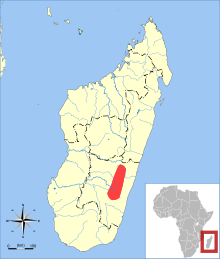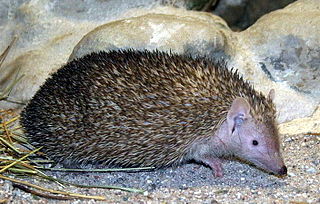
The clade Tenrecoidea or Afrosoricida contains the golden moles of Southern Africa, the otter shrews of equatorial Africa and the tenrecs of Madagascar. These three groups of small mammals were for most of the 19th and 20th centuries regarded as a part of the Insectivora or Lipotyphla. Both groups, as traditionally used, are polyphyletic.

A tenrec is any species of mammal within the afrotherian family Tenrecidae, which is endemic to Madagascar. Tenrecs are a very diverse group; as a result of convergent evolution some resemble hedgehogs, shrews, opossums, rats, and mice. They occupy aquatic, arboreal, terrestrial, and fossorial environments. Some of these species including the greater hedgehog tenrec, can be found in the Madagascar dry deciduous forests. However, the speciation rate in this group has been higher in humid forests.
The four-toed amapasaurus is a lizard that was discovered in 1970 by Osvaldo Rodrigues da Cunha. It is the only species in the genus Amapasaurus.
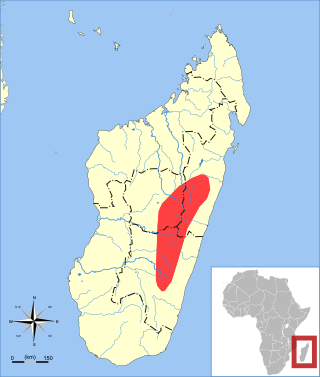
The web-footed tenrec, Malagasy otter shrew, or aquatic tenrec is the only known semiaquatic tenrec, and is found in eastern Madagascar, especially in and around Ranomafana National Park. It grows to between 25 and 39 cm, and was once thought to be extinct. It feeds on crabs, aquatic insects, and crayfish. The population is considered vulnerable. It was formerly placed in the monotypic genus Limnogale, but has been moved to Microgale based on molecular data showing it to be deeply nested within the latter.

A genet is a member of the genus Genetta, which consists of 17 species of small African carnivorans. The common genet is the only genet present in Europe and occurs in the Iberian Peninsula, Italy and France.

The slender shrew is a species of shrew. An adult slender shrew has a weight of 1.5–5.3 g (0.053–0.187 oz) and a body length of 4.7–6.0 cm (1.9–2.4 in), with a tail of 4–5 cm (1.6–2.0 in); this makes it one of the smaller shrews found in its range. It is distributed across northeastern North Korea, Hokkaidō, and the Russian Far East including the Kuril Islands.
Eastwood's longtailed seps, also known commonly as Eastwood's whip lizard was a species of lizard in the family Gerrhosauridae. The species was endemic to South Africa. Its natural habitat was subtropical or tropical high-altitude grassland. It became extinct due to habitat loss.

The mole-like rice tenrec, also known as the fossorial tenrec or hova rice tenrec, is a species of mammal in the tenrec family. Like all other tenrecs, it is endemic to Madagascar. Its natural habitats are subtropical or tropical moist forests, swamps, freshwater lakes, and irrigated or seasonally flooded agricultural land.

Rice tenrecs are the two species in the Malagasy genus Oryzorictes. They are mammals in the family Tenrecidae. It contains the following species:
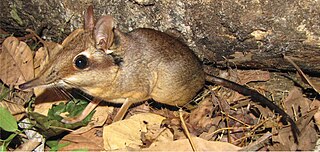
The four-toed elephant shrew or four-toed sengi is the only living species in the genus Petrodromus, which together with five other extant genera Rhynchocyon, Macroscelides, Petrosaltator, Galegeeska and Elephantulus constitutes the order Macroscelidea. This species is only found in particular regions in Africa and is smaller than its relatives. A comprehensive record of this species is lacking.

The Saint Lawrence Island shrew is a species of mammal in the family Soricidae. It is found only on Alaska's St. Lawrence Island.
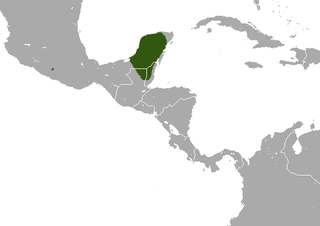
The Yucatan small-eared shrew is a species of mammal in the family Soricidae. It is mainly known from lowlands of Guatemala, Belize and Mexico's Yucatán Peninsula, where it has been found in dry scrubland and tropical dry forest at elevations below 100 m. It is threatened by deforestation.

The Central Highlands, Central High Plateau, or Hauts-Plateaux are a mountainous biogeographical region in central Madagascar. They include the contiguous part of the island's interior above 800 m (2,600 ft) altitude. The Central Highlands are separated from the Northern Highlands of the northern tip of Madagascar by a low-lying valley, the Mandritsara Window, which has apparently acted as a barrier to dispersal for species in the highlands, leading to species pairs such as Voalavo gymnocaudus and Voalavo antsahabensis in the Northern and Central Highlands. Species restricted to the Central Highlands include the bats Miniopterus manavi and Miniopterus sororculus; the rodents Brachyuromys betsileoensis and Voalavo antsahabensis; the tenrecs Hemicentetes nigriceps and Oryzorictes tetradactylus; and the lemur Cheirogaleus sibreei. Because of the continuous habitat of the Central Highlands, there is little local endemism, unlike the Northern Highlands.
Oryzorictinae is a subfamily of tenrecs endemic to the island of Madagascar. It is the largest of three tenrec subfamilies. Oryzorictinae is thought to have split from the lineage of its closest relative, Geogale, about 30 million years (Ma) ago. The deepest phylogenetic split within the subfamily, that between Oryzorictes and a clade composed of Microgale plus Nesogale, is thought to have occurred about 28 Ma ago. In turn, Microgale and Nesogale are thought to have diverged about 19 Ma ago.
The Oaxacan broad-clawed shrew is a species of mammal in the family Soricidae. It is found in Oaxaca in Mexico.

The Indochinese shrew is a species of white-toothed shrew native to Southeast Asia. It was first identified in 1922 by Herbert C. Robinson and C. Boden Kloss. The species is often taxonomized as a subspecies Horsfield's shrew, but bears a different range, occurring in Myanmar, Vietnam, and the Yunnan province of China. C. indochinensis is on the smaller end of shrews, with dark brownish gray fur and a long, slender tail.
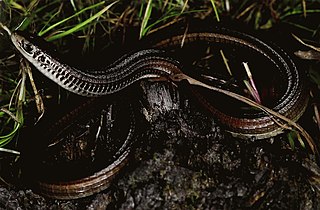
Tetradactylus ellenbergeri, commonly known as Ellen's whip lizard and Ellenberger's long-tailed seps, is a species of lizard in the family Gerrhosauridae. The species is indigenous to Africa.
Tetradactylus fitzsimonsi, commonly known as Fitzsimons' long-tailed seps and FitzSimons' whip lizard, is a species of lizard in the family Gerrhosauridae. The species is endemic to South Africa.
